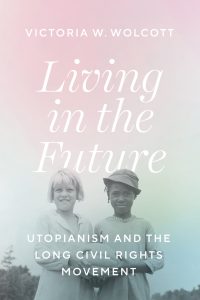Five Questions with Victoria W. Wolcott, author of “Living in the Future: Utopianism and the Long Civil Rights Movement”
Utopian thinking is often dismissed as unrealistic, idealistic, and impractical—completely divorced from urgent issues like repairing the United States’ bitter history of racial injustice. But as Victoria W. Wolcott provocatively argues in her new book Living in the Future: Utopianism and the Long Civil Rights Movement, utopianism is actually the foundation of a rich and visionary worldview, one that specifically inspired the major figures of the Civil Rights Movement in ways that haven’t yet been fully understood or appreciated. We spoke with Victoria about the book, her research, and the unexpected places where utopian thinking pops up.
How did you wind up in your field, and what do you love most about it?
I have always been interested in the power of ordinary people to enact change. As an undergraduate at New York University in the late 1980s, I was determined to be a Political Science major with the goal of both studying and engaging in political activism. But after a semester of studying in Spain where the power of history was everywhere, from the Fascist monuments surrounding Madrid to the medieval fortresses and Roman aqueducts, I changed my major to History. While at NYU I was drawn to labor history, attending lectures at the Brecht Forum, a Marxist education center in Brooklyn, and going to the Socialist Scholars conference, where I heard luminaries of the left including Michael Harrington and Cornel West. Believing (falsely) that the academic job market would expand in the 1990s as the baby boomers retired, I went on to get my PhD at the University of Michigan. My intention in graduate school was to study women’s labor history, but I became captivated by the power of African American history to disrupt traditional narratives. My first two books, Remaking Respectability: African American Women in Interwar Detroit (2001) and Race, Riots, and Roller Coasters: The Struggle Over Segregated Recreation in America (2012), explore the daily acts of resistance that African Americans engaged in to transform their communities and society at large. I’ve continued that examination in Living in the Future. Carrying these stories from archives, where they are dispersed and fragmented, to the printed page and the classroom is what I love most about being a historian. And particularly in these difficult times, the knowledge that ordinary people can wield extraordinary power feels hopeful.
While you were working on Living in the Future, what did you learn that surprised you the most?
Although I was familiar with much of the civil rights history that went into the book, I was surprised by the important role workers’ education played in the burgeoning labor and civil rights movements. Workers’ education was very much a feminist project, started in the 1910s by organizers in the International Ladies Garment Workers Union (ILGWU) who sought both to unionize women’s workers and improve their daily lives. Fannia Cohn, one of the founders of Brookwood Labor College, said of the movement, “It dreams of a world where economic and social justice will prevail, where the welfare of mankind will be the aim of all activity, where society will be organized as a cooperative commonwealth.” To achieve this dream proponents of workers’ education created communities that taught workers not only organizing strategies, but literature, art, and history. Brookwood Labor College and the Highlander Folk School grew out of workers’ education and were instrumental in training activists like Ella Baker, Pauli Murry, and Rosa Parks. These institutions also developed a range of resistance strategies, including sit-ins, that became central to twentieth-century social movements. The creativity and comprehensiveness of workers’ education have something to teach the current labor movement. As new kinds of workers and workplaces organize, they will need to develop innovative strategies and be ambitious about the possibility of creating both a new kind of union and a new kind of society.
What do you most hope readers take away from the book?
My wish is that readers appreciate the importance of social dreaming, the essence of utopianism, in social movements. Given the violence and racism that continues to pervade American society it is easy, and even rational, to fall into a place of despair. But history tells us that activists who imagined a different future practiced egalitarianism in their daily life, as well as in their political work, and created real change. In places like the Highlander Folk School, where African American and white organizers worked and played side by side, a utopian vision of the future was enacted. This form of social dreaming has a long and powerful history in the United States. Alongside the history of capitalism and individualism in American society is a history of communalism and cooperation that has been largely ignored. This alternate tradition fueled the abolitionist movement in the nineteenth century and the civil rights movement in the twentieth. Even amid all our challenges, that history can be a driver of change today.
Where will your research and writing take you next?
In my last two books, I encountered a remarkable African American activist, Eroseanna Robinson, whose life story I am committed to writing. In the cold war decades following World War II Robinson defied the U.S. government, Jim Crow segregation, and prevailing social mores to exercise her free will as an athlete and an activist. Her success in track and field gave her a platform to express her defiance of militarism, gender discrimination, and racial hierarchies. Robinson refused to stand for the national anthem at a 1959 meet, refused to travel to the Soviet Union as a representative of American track and field, and was the first woman to be imprisoned for her refusal to pay taxes. My book, tentatively titled The Embodied Resistance of Eroseanna Robinson: Athleticism and Activism in the Cold War Era, will explore Robinson’s life and illuminate a cold war counterculture where a Black woman could defy expectations and exercise her autonomy. Eroseanna Robinson’s life demonstrates that the most marginalized people can have a significant impact on society. I can’t wait to share her story with readers.
What’s the best book you’ve read recently?
I have long been a fan of speculative and science fiction, which has fueled my interest in utopia. I just finished Becky Chambers’s beautifully written Monk and Robot solarpunk novellas, Psalm for the Wild Built and Prayer for the Crown Shy. Solarpunk is a subgenre of science fiction that portrays futures in which technology and humanity live in harmony. Chambers’s short books are set in a world, Panga, that has experienced what the inhabitants call the “transformation,” restoring ecological balance and rejecting fossil fuels and most forms of technology. This transformation was spurred by a mass exodus of robots to the wilderness after they achieved consciousness and rejected humans. The two protagonists are a robot named Mosscap who has come out of the wilderness to check on humanity, and a monk named Dex, who uses a tea ceremony to provide comfort and wisdom to Panga’s inhabitants. What I particularly appreciated about the novellas is that although this utopia presents a world in which people have all they need, Chambers makes it clear that human suffering and questioning remain. That is, utopia does not necessarily transform human nature. But Chambers’s hopeful vision is deeply comforting and beautifully wrought in these challenging times.

Victoria W. Wolcott is professor of history at the University of Buffalo.
Living in the Future is available now from our website or your favorite bookseller.
